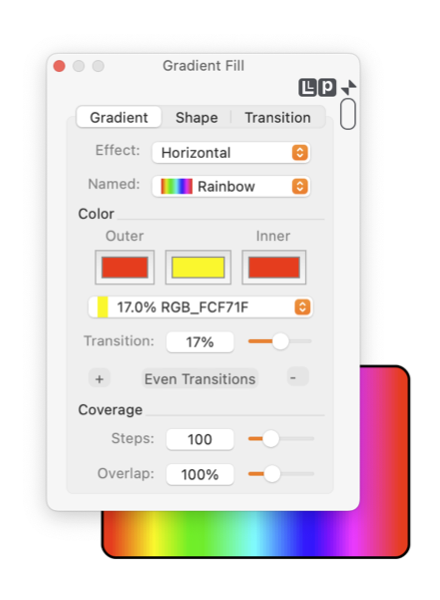

|

|
|
The Gradient Fill panel is used to fill graphics with a blend of two or more colors. The Fill of the graphic transitions from one color to the other. The transition may follow various contours and mathematical blending functions. The panel is shown to the left. Detailed documentation of each parameter is available by clicking the links below. To show this panel select "Gradient Fill" from the Tools Menu which is on the Main Menu. In order to apply a "Gradient Fill" to a graphic (or graphics) it must be the selected graphic in the top window of EazyDraw. If no graphic is selected the parameters on the panel represents the Gradient Fill that will be used when creating new graphics. Follow the Target Graphic(s) link for more information on this topic.
Bitmap gradients will reproduce faithfully for bitmap output (TIFF, PNG, JPG, ...) but may not have good appearance when output to PDF and transparent colors are not supported for pdf output. To repeat: transparent colors are not supported for bitmap gradients printed to a printer or to PDF but-- vector gradients do support transparency for PDF output. PDF drawings that contain several vector gradients may become rather large. In this case a bitmap gradient might be preferable. The vector gradients offer greater design possibilites than bitmap gradients. Bitmap gradient definitions are more limited and stanard as they correspond to the specifications supported by SVG (and CSS). Vector gradients are similiar to EazyDraw Blends which are drawn exclusively with vector paths. If a these gradient effects prove limiting for a particular need - investigate use of a Blend instead. You may save a user designed gradient for convenient reuse. Named gradients are accessed from the popup menu found near the top of the Gradient tab on the Gradient Fill palette. All named gradients are saved in one disk file in the EazyDraw's applications support folder which is normally found in the users home Library folder. The named gradients are saved in a disk file in the Applications Support folder of your home Library folder. So the path is "Tilde_forHome"->Library->Application Support->EazyDraw->Gradients.plist . The file is a human readable text file. It may be edited with any text editor or the Apple supplied pList editor. You may back-up the current set of named gradients by duplicating and archiving the Gradients.plist file discussed in the above paragraph. This is suggested if any amount of time has been invested in creating new custom gradients. The default set of EazyDraw gradients may be re-generated by moving the Gradients.plist file out of the EazyDraw applications support folder - and re-starting EazyDraw. The default set of gradients is derived from an EazyDraw drawing that is included as a resource file in the EazyDraw application Bundle. As a reference for expert users or language translation engineers: the file is DKDNamedGradients.ezdraw; the format is a simple set of group graphics that contain a Bezier path (rectangle) with a gradient fill and Text Area graphic with the associated shape name. |